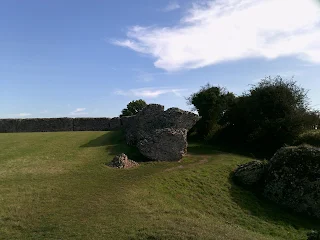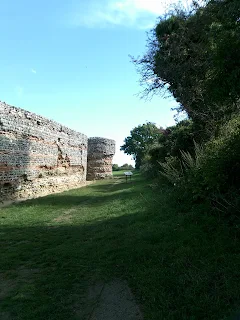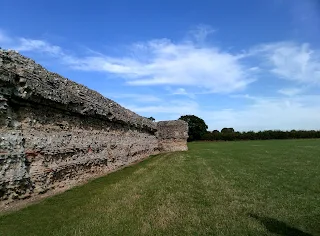Burgh Castle, along with Caister, were part of a string of forts along what the Romans called the 'Saxon Shore'. Burgh would have operated in conjunction with Caister and one (or both) were thought to have been named Gariannonum. They would have been naval bases and perhaps trading posts. Saxon raids were kept at bay until AD 367, when Saxons, Scots and Picts made a more concerted attack.
This map shows its location, above the River Waveney estuary. A lot of the water is now dry, but some is left and forms part of the Norfolk Broads.
Originally enclosing about six acres, the castle was built in the 3rd century AD and we were advised to visit it after chatting to a local man about Caister Roman Fort. Unlike Caister, though, little evidence survives to give us an idea of this fort's layout.
It was an absolutely glorious day when we visited and some of my photographs show brilliant, shifting clouds. It was a bit of a pain in the butt to get to from our holiday home in Caister- involving two buses and keeping your eyes peeled for the correct countryside bus stop- but was well worth it.
Firstly, we walked past the church of St Peter and St Paul. With some parts dating over 1000 years, it is one of 124 round tower churches in Norfolk. Dippy me saw the tower and wrongly said, 'Oh, that must be the castle!'
This was the first time I had ever seen the Norfolk Broads and the views were stunning. Over the water is the remote (inaccessible by road) settlement of Berney Arms, which consists of a pub which takes its name from the area, a windmill, a farmhouse and a railway station (little more than a platform) which operates on a request stop basis. Parts of it are below sea level.
A lone boat making its way along the River Waveney confluence.
This area is known as Breydon Water.
The castle formed a quadrangle, but only three walls still exist. The other has fallen into what was once an estuary, but is now a marsh.
The walls once reached a height of around 4.5 metres. They would have been 3.5 metres thick at their base, tapering to 1.5 metres thick at the top.
The walls were constructed on both the inside and outside of the fort with facing consisting of alternating bands of cut flint and tile, with a mortared flint rubble core. Over the years, they have been plundered for building materials.
Corner bastions. They have holes which were used for either anchoring catapults or supporting timber watchtowers.
Chunks of castle and the view over the Broads...
Our leaving views of the castle...
It really is a desolate part of the county- but beautiful in its peacefulness too. Would I return? On a lovely day, maybe... especially if I could arrive by water...
TTFN
The Miss Elaineous.
XXXXXXXXXXXXXXXXXXXXXXXXXXXXXXXX




















No comments:
Post a Comment